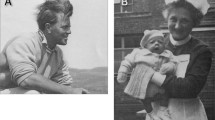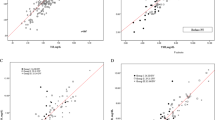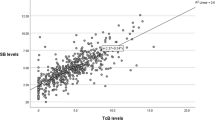Abstract
OBJECTIVE: Turning of infants during phototherapy for hyperbilirubinemia is practiced in many nurseries. However, there is little research evidence in support of this practice. This study examined the effect of turning on serum total bilirubin concentration and on the duration of phototherapy.
STUDY DESIGN: We first conducted a pilot study in term infants requiring phototherapy using transcutaneous bilirubinometry in order to determine the time required to clear the skin of bilirubin. This “blanching time” was found to be approximately 150 minutes. We then conducted a randomized study comparing turning the baby during phototherapy with care in the supine position only.
RESULTS: Thirty term infants were enrolled in the study (turned — 14; supine — 16). No differences were found between the groups in baseline data, such as birth weight, gestational age, age at start of phototherapy, or type of feeds. Infants in the supine group showed a significantly larger drop in serum total bilirubin concentration and required a shorter duration of phototherapy.
CONCLUSION: We conclude that infants should be nursed supine during phototherapy. Based on these results, we propose a modification to the traditional model of bilirubin kinetics during phototherapy.
This is a preview of subscription content, access via your institution
Access options
Subscribe to this journal
Receive 12 print issues and online access
$259.00 per year
only $21.58 per issue
Buy this article
- Purchase on Springer Link
- Instant access to full article PDF
Prices may be subject to local taxes which are calculated during checkout


Similar content being viewed by others
References
American Academy of Pediatrics. Practice parameter: management of hyperbilirubinemia in the healthy term newborn Pediatrics 1994 94: 558–65
Hansen TWR . Therapeutic approaches to neonatal jaundice: an international survey Clin Perinatol 1996 309–16
Vogl TP . On the dynamics of phototherapy In: Brown AK, Showacre J, editors Phototherapy for Neonatal Hyperbilirubinemia—Long-Term Implications NIH Publication 1974 219–25
Vogl TP . Phototherapy of neonatal hyperbilirubinemia: bilirubin in unexposed areas of the skin J Pediatr 1974 85: 5 707–10
Weise G . Pharmacokinetic studies on intermittent phototherapy in neonates Physiologic Foundations of Perinatal Care Elsevier 1989 pp 183–8
Cremer RJ . Influence of light on the hyperbilirubinemia of infants Lancet 1958 1: 1094–7
Maurer HM, Shumway CN, Draper DA, Hossaini AA . Controlled trial comparing agar, intermittent phototherapy and continuous phototherapy for reducing neonatal hyperbilirubinemia J Pediatr 1973 82: 73–6
Rubaltelli FF, Zndaro V, Granati B . Effect of various phototherapy regimens on bilirubin decrement Pediatrics 1978 61: 838–41
Ballowitz L, Geutler G, Pannitschka R, Roemer G, Roemer I . Phototherapy in Gunn rats Biol Neonate 1977 31: 229–44
Yamauchi Y, Kasa N, Yamanouchi I . Is it necessary to change the babies' position during phototherapy Early Hum Dev 1989 20: 221–7
McDonagh AF, Palma LA, Lightner DA . Blue light and bilirubin excretion Science 1980 208: 145–51
Pratesi R, Ronch L, Cecchi G et al. Skin optics and phototherapy of jaundice Photochem Photobiol 1984 40: 1 77–83
Malhotra V, Greenberg JW, Dunn LL, Ennever JF . Fatty acid enhancement of the quantum yield for the formation of lumirubin from bilirubin bound to human albumin Pediatr Res 1987 21: 6 530–3
Anderson RR . Tissue optics and photoimmunology In: Parrish JA, editor Photoimmunology New York: Plenum 1983 pp 73
Walter FJ, Wu PYK, Siassi B . Cardiac output changes in newborns with hyperbilirubinemia treated with phototherapy Pediatrics 1985 76: 6 918–92
Ennever JF . Blue light, green light, white light, more light: treatment of neonatal jaundice Clin Perinatol 1990 17: 2 467–81
Acknowledgements
We express our deep gratitude to the late Prof. Abraham Kushilevsky of the Department of Physics, Ben-Gurion University, Beersheba, Israel, for his major contribution in development of the hypothetical model of bilirubin kinetics.
Author information
Authors and Affiliations
Rights and permissions
About this article
Cite this article
Shinwell, E., Sciaky, Y. & Karplus, M. Effect of Position Changing on Bilirubin Levels During Phototherapy. J Perinatol 22, 226–229 (2002). https://doi.org/10.1038/sj.jp.7210678
Published:
Issue Date:
DOI: https://doi.org/10.1038/sj.jp.7210678
This article is cited by
-
Sixty years of phototherapy for neonatal jaundice – from serendipitous observation to standardized treatment and rescue for millions
Journal of Perinatology (2020)
-
Effect of position of infant during phototherapy in management of hyperbilirubinemia in late preterm and term neonates: a randomized controlled trial
Journal of Perinatology (2013)



